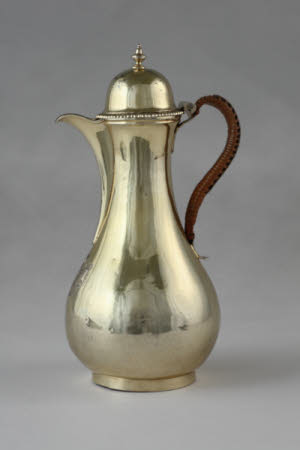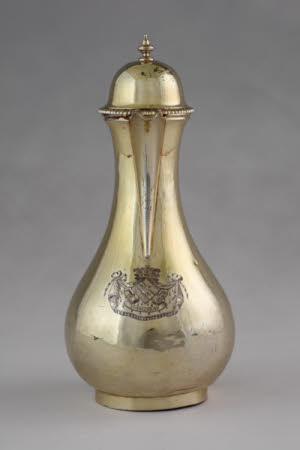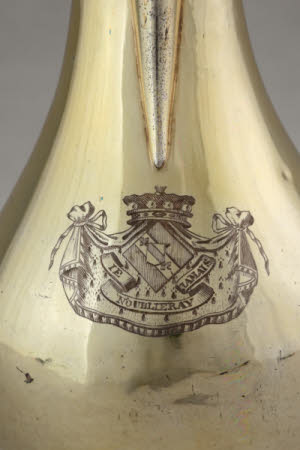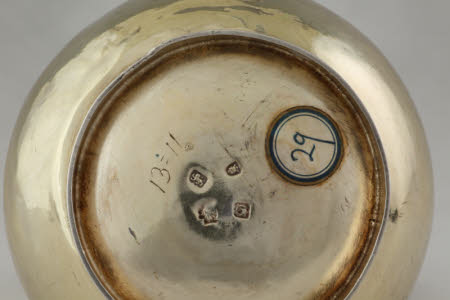Coffee pot
Frederick Kandler
Category
Silver
Date
1762 - 1763
Materials
Silver-gilt, sterling.
Measurements
24.4 x 13.3 cm; 11.4 cm (Diameter)
Place of origin
London
Order this imageCollection
Ickworth, Suffolk
NT 852072
Summary
Coffee pot, sterling silver, gilt, by Frederick Kandler, London, 1762/3. The elongated pear-shaped body, which is raised, splays towards the rim and has an applied, beak-shaped spout, also raised. The flattened base has an applied and seamed foot ring and the handle is formed of a curved strip of sheet silver, wickered. A five-part pin hinge is fixed to the handle. The domed cover is raised and has a cast and chased gadroon rim, a seamed bezel and a cast baluster finial. Heraldry: The contemporary engraving on the front of the pot, beneath the spout, shows the motto and arms (Hervey with Lepel in pretence) in a lozenge of Lady Hervey as a widow in an ermine mantling beneath a baron’s coronet.
Full description
Jugs for hot water are rarely if ever mentioned in the Wickes ledgers, apart from those associated with shaving, and they are also absent from the 1811 Bristol plate list. There are not even examples, again excepting shaving ewers, amongst the prodigious collections of the 2nd Earl of Warrington at Dunham Massey and the 1st Duke of Chandos at Cannons, between which most silver objects in domestic use are represented.[1] Many of the vessels identified as hot-water jugs in recent years, including this one, are likely to have been coffee pots, which this is recorded as in 1874.[2] The pear-shaped body reflects the French form of the late seventeenth century which had persisted on the Continent but was rarely employed in England again until the 1750s. It may well have appealed to Lady Hervey as an avowed Francophile. The coffee pot was either bought with cash or it was from stock and formed part of Lady Hervey’s last order to Frederick Kandler, whom she had been patronising since the early 1750s. Her bank account with Goslings reveals that there were no payments to Kandler in the mid 1760s but that she paid him £34 on 9 July 1768, just under two months before her death.[3] That would have been enough for about 90 ounces of silver at 7s 8d, or less if many of the pieces were gilt, as is the coffee pot. This is probably the gilt coffee pot listed in the 1811 plate list (appendix 5) as weighing 12 ounces, an allowance having been made for the handle. It is recorded with its scratchweight in the 1874 plate list.[4] James Rothwell, Decorative Arts Curator January 2021 [Adapted from James Rothwell, Silver for Entertaining: The Ickworth Collection, London 2017, cat. 22, p. 100.] Notes: [1] See James Lomax and James Rothwell, Country House Silver from Dunham Massey, 2006, pp. 167-183 and Susan Jenkins, ‘ “An Inventory of His Grace the Duke of Chandos’s Seat at Cannons taken June the 19th 1725” by John Gilbert’, The Walpole Society, vol. 67 (2005), pp. 121, 125 and 140-8 for the 1750/54 and 1725 plate lists of Dunham Massey and Cannons. [2] Suffolk Record Office, 941/75/3, Bristol plate lists 1874. [3] Barclays Group Archives, Goslings ledgers, 130/41, f. 404. [4] Bristol plate lists 1874 (see note 2).
Provenance
Mary Lepel, Lady Hervey (1706-68); by descent to the 4th Marquess of Bristol (1863-1951); accepted by the Treasury in lieu of death duties in 1956 and transferred to the National Trust.
Credit line
Ickworth, the Bristol collection (National Trust)
Marks and inscriptions
Hallmarks: Fully marked on the underside with maker’s mark ‘FK’ in italics beneath a fleur-de-lis (Arthur Grimwade, London Goldsmiths 1697-1837, 1990, no. 691), lion passant, date letter ‘G’. The bezel of the lid is marked with the lion passant only. Underside: Scratchweight: ‘13=11’ Underside: Round paper label with blue lines, inscribed in ink ‘29’.
Makers and roles
Frederick Kandler, goldsmith




